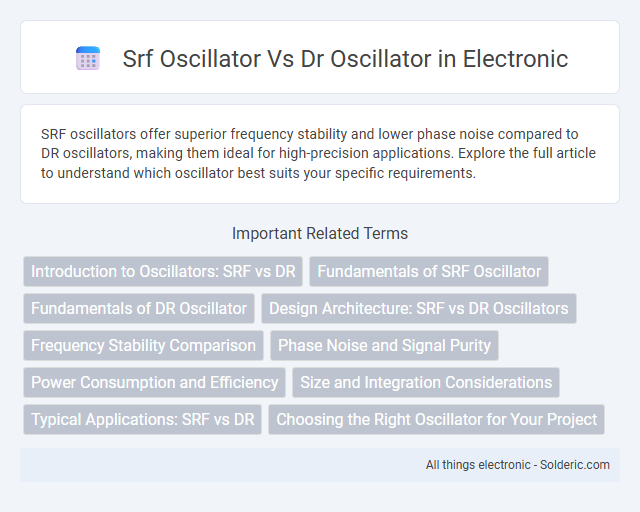SRF oscillators offer superior frequency stability and lower phase noise compared to DR oscillators, making them ideal for high-precision applications. Explore the full article to understand which oscillator best suits your specific requirements.
Comparison Table
| Feature | SRF Oscillator | DR Oscillator |
|---|---|---|
| Full Name | Series Resonant Frequency Oscillator | Damped Resonator Oscillator |
| Operating Principle | Uses series resonance circuit for frequency control | Employs a damped resonator circuit for oscillation |
| Frequency Stability | High stability due to series resonance | Moderate stability; affected by damping factor |
| Q Factor | High Q factor | Lower Q due to damping |
| Oscillation Amplitude | Consistent and stable amplitude | Amplitude decreases over time due to damping |
| Typical Applications | Precise frequency generation, RF circuits | Simpler circuits, short-lived signals |
| Complexity | More complex design | Simpler and easier to implement |
Introduction to Oscillators: SRF vs DR
SRF oscillators, based on the Series Resonant Frequency, achieve precise frequency control by leveraging the inherent properties of inductors and capacitors in series resonance circuits, making them ideal for high-frequency applications. DR oscillators, or Double Resonance oscillators, utilize two resonant circuits that enhance frequency stability and signal purity, often preferred in communication systems requiring minimal phase noise. Understanding your application's frequency stability and signal purity requirements guides the choice between SRF and DR oscillator designs.
Fundamentals of SRF Oscillator
SRF oscillators rely on the high quality factor (Q-factor) of substrate integrated waveguide or dielectric resonators to generate stable frequencies with minimal phase noise. Their operation depends on electromagnetic resonance in specialized cavities, resulting in superior frequency selectivity and low signal distortion. Understanding the fundamentals of SRF oscillators helps you select the ideal solution for applications demanding precision frequency control and enhanced signal integrity compared to traditional DR oscillators.
Fundamentals of DR Oscillator
The DR oscillator operates based on the resonance between mutual inductance and capacitance, utilizing two coupled inductors to achieve high frequency stability and low phase noise. Unlike the SRF oscillator, which relies primarily on a single resonant tank circuit, the DR oscillator uses a dual-resonance mechanism that enhances frequency selectivity and reduces signal distortion. This fundamental approach enables DR oscillators to deliver superior performance in radar, communication, and signal processing applications by minimizing energy losses and improving spectral purity.
Design Architecture: SRF vs DR Oscillators
SRF oscillators utilize a series-resonant tank circuit that emphasizes high current resonance at the fundamental frequency, resulting in low phase noise and high frequency stability. DR oscillators, on the other hand, employ a double-resonant architecture combining both series and parallel resonance, which enhances frequency selectivity and reduces power consumption. Your choice between SRF and DR oscillator design architectures depends on the trade-offs between noise performance, frequency stability, and energy efficiency required for the application.
Frequency Stability Comparison
SRF oscillators offer superior frequency stability due to their reliance on surface acoustic waves that maintain consistent oscillation characteristics over temperature variations and environmental changes. DR oscillators, while effective, exhibit more frequency drift as their dielectric resonators are more susceptible to thermal expansion and mechanical stress. For applications requiring precise and stable frequency output, your best choice is typically the SRF oscillator.
Phase Noise and Signal Purity
SRF oscillators exhibit lower phase noise due to their high Q-factor resonators, enhancing signal purity with minimal spectral spreading. DR oscillators, while offering compact size and integration, typically suffer from higher phase noise, which can degrade signal fidelity. Optimizing SRF oscillator designs remains crucial for applications demanding superior phase noise performance and ultra-pure signals.
Power Consumption and Efficiency
SRF oscillators typically exhibit lower power consumption due to their high Q-factor resonators, which allow stable oscillation at reduced driving currents, enhancing overall efficiency in RF applications. DR oscillators, while often simpler and more cost-effective, generally consume more power as their resonator designs provide lower Q-factors, demanding higher energy input to maintain oscillations. The superior energy efficiency of SRF oscillators makes them preferred in battery-powered and low-noise environments where minimizing power consumption is critical.
Size and Integration Considerations
SRF oscillators typically offer a smaller footprint due to the compact nature of their high-Q resonators, making them ideal for integrated circuits in size-constrained applications. In contrast, DR oscillators require larger bulk acoustic resonators, which result in increased size and pose challenges for seamless integration into highly miniaturized systems. The integration of SRF oscillators is generally more straightforward with modern semiconductor processes, enhancing their suitability for on-chip applications where space efficiency is critical.
Typical Applications: SRF vs DR
SRF oscillators are commonly used in applications requiring stable frequency references such as clocks and radios due to their low phase noise and high frequency stability. DR oscillators excel in environments needing robust and tunable frequency generation like signal processing and communication systems, offering greater frequency agility. Your choice between SRF and DR oscillators depends on whether you prioritize frequency accuracy or flexibility for your application.
Choosing the Right Oscillator for Your Project
Selecting between an SRF oscillator and a D-R oscillator hinges on your project's frequency stability and power consumption requirements. SRF oscillators deliver superior frequency precision with low phase noise, ideal for high-performance RF applications, whereas D-R oscillators excel in simplicity and energy efficiency, suitable for battery-powered or low-cost designs. Evaluating factors such as operating frequency range, integration complexity, and environmental sensitivity will ensure optimal oscillator performance tailored to your specific circuit needs.
srf oscillator vs dr oscillator Infographic

 solderic.com
solderic.com